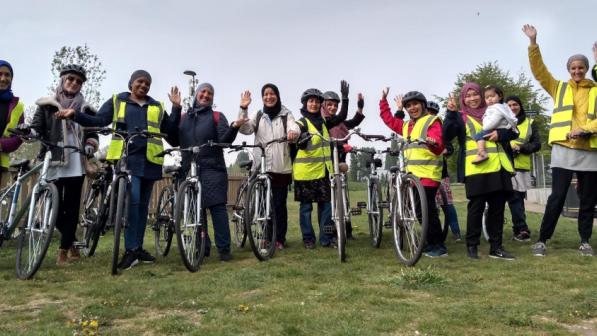How to lead a group cycle ride
By Julie Rand

Follow Cycling UK’s Guide to Leading a Group Ride
Being a ride leader is enjoyable, rewarding and fun: you have the satisfaction of sharing your knowledge and skills with others and, best of all, you get to choose when and where you ride! This guide will help you and your group get the most out of the experience.
Becoming a ride leader
- Speak to someone on your committee so they can register you in order to be covered by our insurance.
- Familiarise yourself with the advice for riders in How to take part in a group ride.
Before the ride
- Work out a route your group is likely to enjoy, taking into account: distance; terrain; traffic; refreshments; toilets; points of interest; weather; ability of the riders; and any other factors.
- Be prepared to vary the ride if any of these change.
- Decide how you will navigate: GPS, maps, local knowledge, or a combination of all of these?
- Advertise your ride – don’t forget to include: the meeting time and place; the approximate distance and pace; likely return time; and other essentials such as what the riders should bring.
Leading the ride
- Find out the names of everyone on your ride – not just for insurance purposes but it’s also friendlier. Ask riders to complete a Signing On Sheet so you know who's on the ride and have a note of their In Case of Emergency contact details.
- Enlist the help of any experienced riders to keep an eye on newer ones; act as backmarkers; lead a second group; or even act as ‘human signposts'; at junctions or gates.
- Explain how you will lead the ride: any jargon and hand signals you might use; when and where you will wait for stragglers; how you will deal with traffic and so on but remind each rider they are responsible for their own safety.
- Point out any likely hazards in advance. In the unlikely event of a collision or other incident on the ride, please complete an Accident/Incident Report form as soon as possible.
- Avoid blocking roads and trails – choose stopping points carefully.
- Keep the ride flowing smoothly but do stop occasionally and give stragglers a rest before restarting.
- You have a duty of care to the riders and the public, so if you think someone may endanger themselves or others, have a quiet word; if their behaviour persists, you are entitled to ask them to leave the ride.
- You should lead by example and remain courteous and considerate to all road users and fellow riders.
- Ensure anyone who wishes to leave the ride is happy to make their own way home.
- At the end of the ride, thank people for coming and let them know details of the next one, if you have them.
- Then go home and plan your next route!
It’s a good idea to carry a few essential items such as:
- Maps or GPS unit
- Selection of small tools, inner tubes, tyre levers and a puncture repair kit
- Mobile phone
- Cards or coins for phone box – in some areas there may be no signal
- Signing On Sheet
- Pen or pencil



